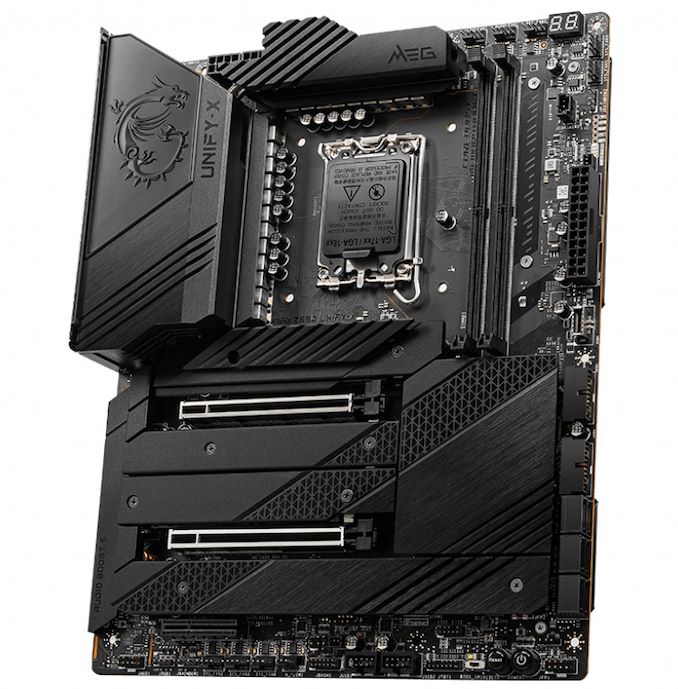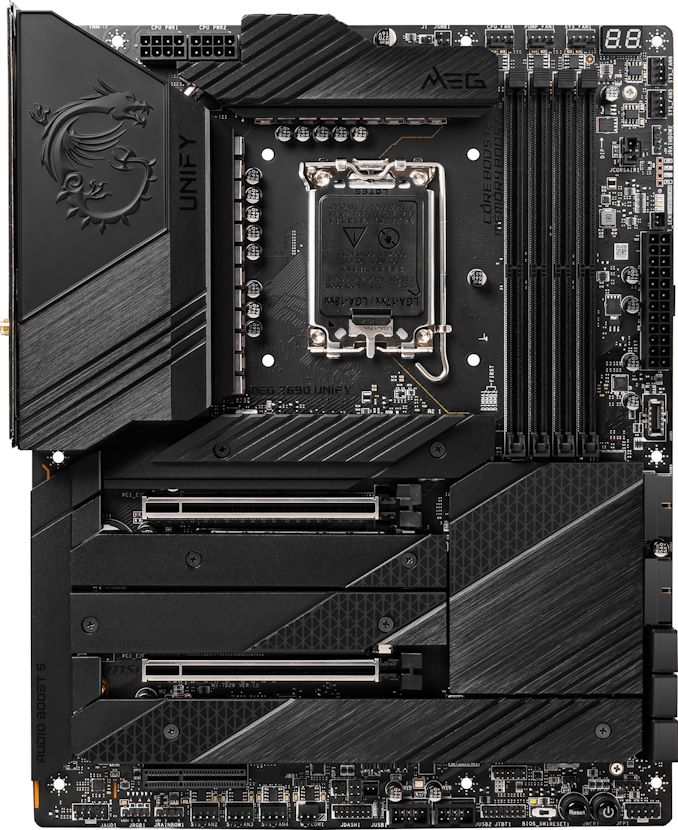The Intel Z690 Motherboard Overview (DDR5): Over 50+ New Models
by Gavin Bonshor on November 9, 2021 9:00 AM ESTMSI MEG Z690 Unify (DDR5) & Z690 Unify X (DDR5)
Sitting below the Godlike and Ace models in MSI's product stack is a pair of Unify branded models. Both the MSI MEG Z690 Unify and Z690 Unify X are a part of the MEG (MSI Enthusiast Gaming) series, with the same core feature set, but with two distinct differences. Aesthetically, both models share the exact same all-black aesthetic we've come to love from the Unify series. This approach was initially marketed as an alternative to RGB clad models, but it has become a solid series for enthusiasts with premium features, good power delivery specifications, and of course, pricing.

The MSI MEG Z690 Unify X with two DDR5-6800 capable memory slots
The MEG Z690 Unify features four memory slots with support for up to 128 GB of DDR5-6666 and is more suitable for gaming, while the MEG Z690 Unify X is aimed at extreme overclockers and enthusiasts with just two memory slots capable of supporting up to 64 GB of DDR5-6800.

The MSI MEG Z690 Unify with four memory slots capable of supporting DDR5-6666
Aside from the obvious differences in memory compatibility and support, both the MEG Z690 Unify and Unify X includes two full-length PCIe 5.0 slots operating at x16 and x8/x8, with a half-length PCIe 3.0 x4 slot. MSI is advertising a large 21-phase power delivery for both models, with both models sharing the same all-black and non-RGB enabled aesthetic, which is sure to please users looking for a more subtle look. Storage options are impressive across both models with four PCIe 4.0 x4 M.2 slots, one PCIe 3.0 x4 M.2 slot, and six SATA ports with support for RAID 0, 1, 5, and 10 arrays.
Both the MSI MEG Z690 Unify and Z690 Unify X are using the same controller set, and as a consequence, the rear panels are exactly the same. On the rear panel of both boards include one USB 3.2 G2x2 Type-C, seven USB 3.2 G2 Type-A, and two USB 2.0 ports. Networking support is strong, with two Intel I225-V 2.5 GbE controllers, and an Intel AX210 Wi-Fi 6E CNVi offering both wireless and BT 5.2 support. MSI hasn't specified the audio controllers, but there are five 3.5 mm audio jacks and a S/PDIF optical output powered by a Realtek ALC4080 HD audio codec. FInishing off the rear panel is a PS/2 combo port, a BIOS flashback button, and a clear CMOS button.











126 Comments
View All Comments
GeoffreyA - Saturday, November 13, 2021 - link
Certainly, there are tradeoffs, keeping a socket; but, as Mr. Tuvok would say, "Ryzen, you are an unending source of astonishment." There was a time when sockets even took CPUs from different manufacturers. I remember my Socket 7 motherboard, though I never tried it, could take a K5 and some Cyrix CPUs as well. Those 5x something, something. How things have changed.A short-lived socket can be a pain in the behind too. I was one of those unlucky folk who ended up with Socket 754 and missed out on dual-channel DDR and a long upgrade path. In any case, that computer went kaput after four years.
Oxford Guy - Wednesday, November 10, 2021 - link
Overclocking is for employees of motherboard companies.ECC RAM support should have been a standard feature from the beginning. Apple offered it on the Lisa in ‘83 and consumer computing has gone backward since.
Doublers, though... aren’t a bad thing as long as they’re implemented well — as I understand it. Better to have a good doubler implementation than a weak individual phase system. The main thing is to have a board meet the minimum spec for reliable (i.e. not overheating and/or failing) long-term support of its supported CPUs. Anything beyond that is unnecessary.
GeoffreyA - Saturday, November 13, 2021 - link
The problem with doublers is, they over-use it as a marketing technique to give the impression that a certain board has a large amount of phases.Oxford Guy - Saturday, November 13, 2021 - link
Weak phases with a mediocre/poor regulator aren’t necessarily better than ‘marketing phases’ via the use of doublers. That’s the case when the doublers are used a correctly.There are a lot of shenanigans, though — like not even utilizing the doubler fully but counting it as the doubling of phases. I also recall that one of the big tricks was putting extra chokes on the board to make it look like there are more phases.
GeoffreyA - Sunday, November 14, 2021 - link
Quite right, and one of the reasons why people have got to read a proper analysis of the VRM, or take a look at the lists on hardwareluxx for example.t.s - Tuesday, November 9, 2021 - link
Wish Intel go with their atv12vo. Or like business lines from HP, Dell, Lenovo, etc. 6 or 8 pin.shabby - Tuesday, November 9, 2021 - link
Mobo prices will go up even more, screw that.meacupla - Tuesday, November 9, 2021 - link
In the long term, I think the cost for ATX12VO will be cheaper.ATX12VO PSU will be cheaper than a comparable quality ATX PSU.
The BoM for 12V to 5V and 12V to 3.3V converters would go down, if mobo makers decide to stick to a single, standardized design.
With the way things are looking, electricity prices are unlikely to go down and continue to go up.
DigitalFreak - Tuesday, November 9, 2021 - link
All ATX12VO is doing is shifting the cost from the PSU to the motherboard.Wrs - Wednesday, November 10, 2021 - link
If mobo makers can stick to one design why can't PSU makers? They already conform to ATX.ATX 12 VO increases costs for piecemeal upgraders because of the simple observation that PSUs outlive motherboards. The question would be whether the power savings are worth it. For prebuilts they're comparing power savings to 0 net component cost so 12VO is already the norm.